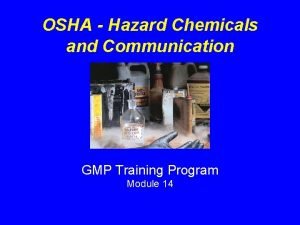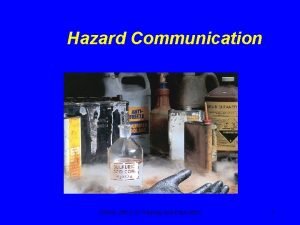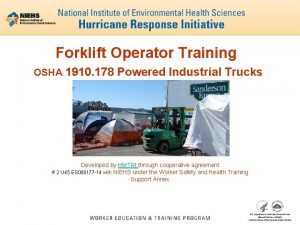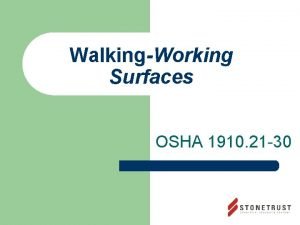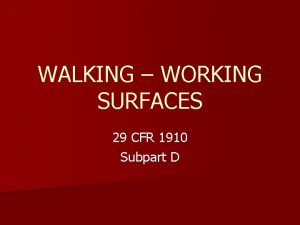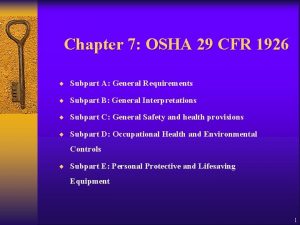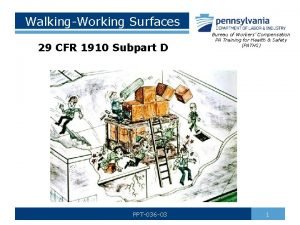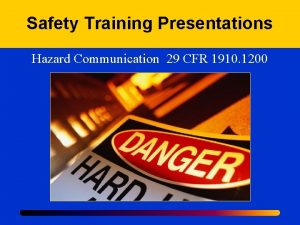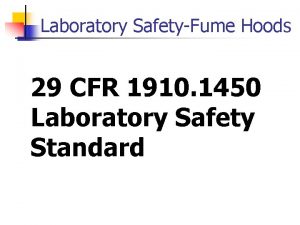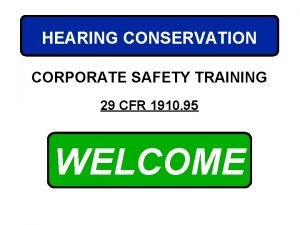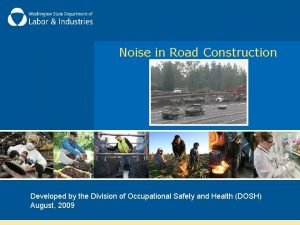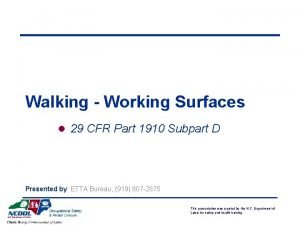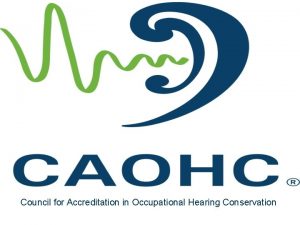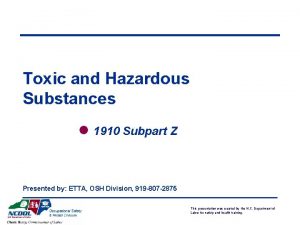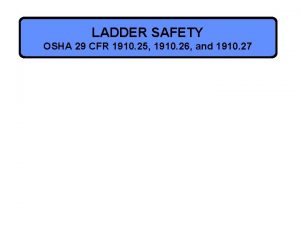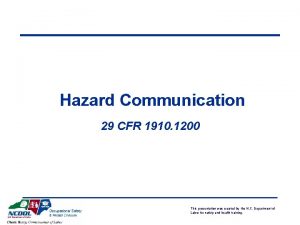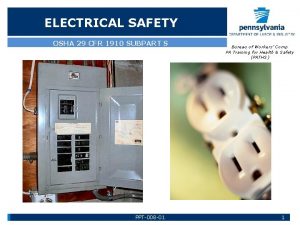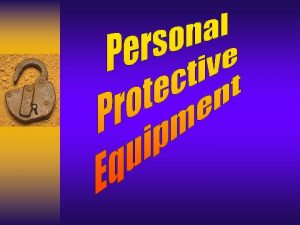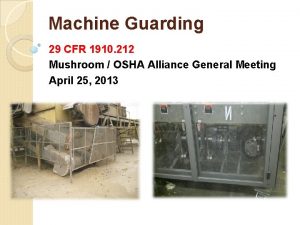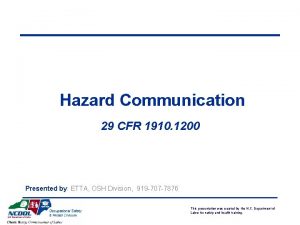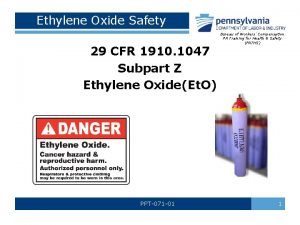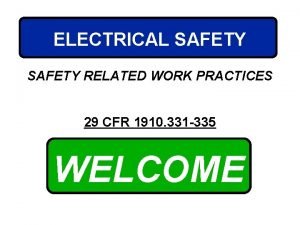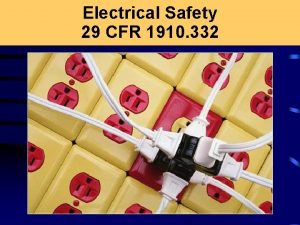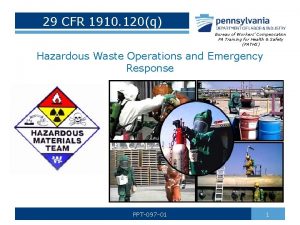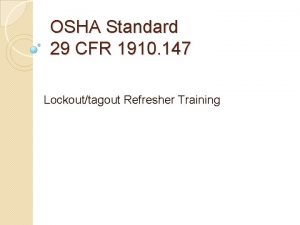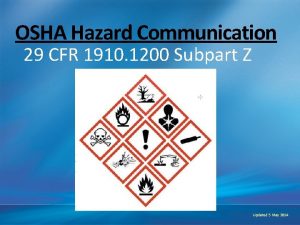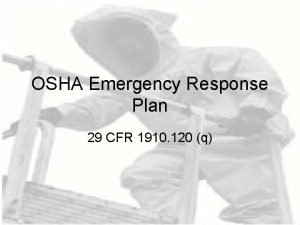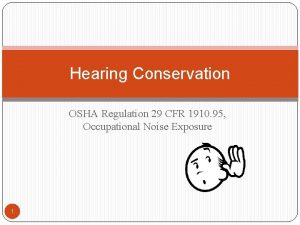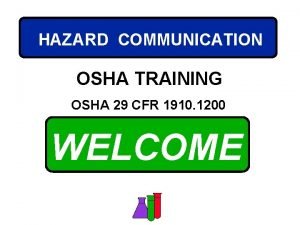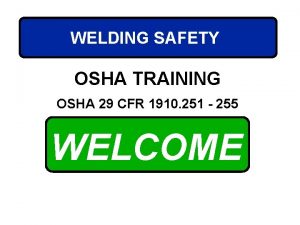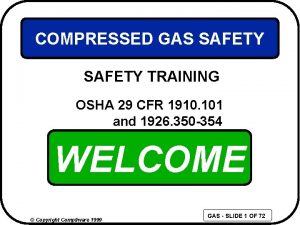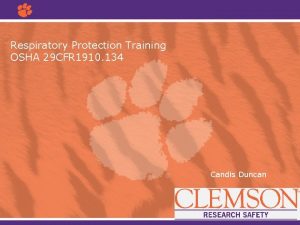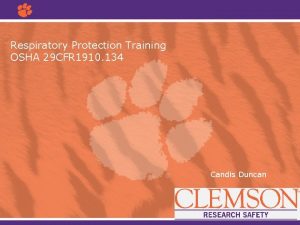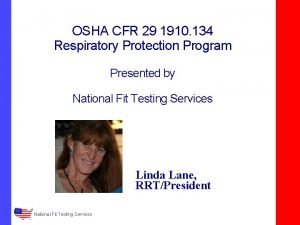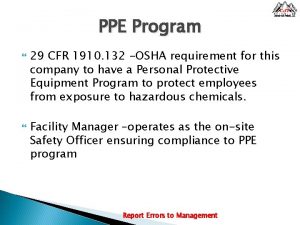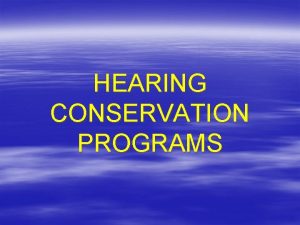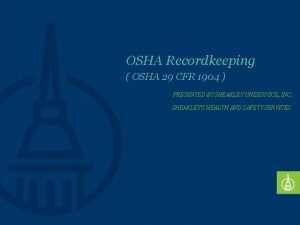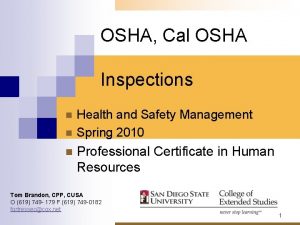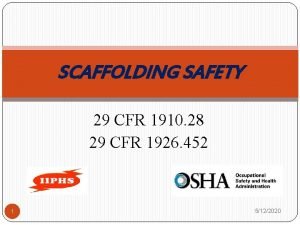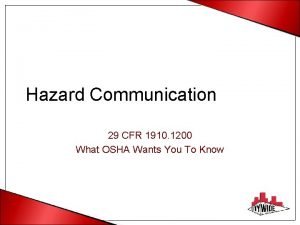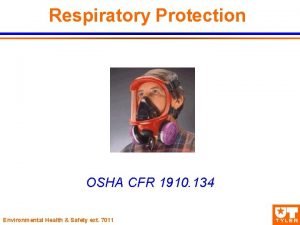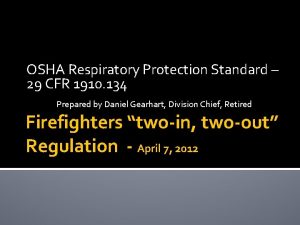Hearing Conservation Program Training OSHA 29 CFR 1910

































- Slides: 33

Hearing Conservation Program Training OSHA 29 CFR 1910. 95 Presented by: Candis Duncan

Introduction • Objective • Science of Hearing • Hearing Conservation Program • Hearing Loss & Effects of Noise on Hearing • Hearing Protection Devices • Noise Reduction Rating • Hearing Protectors & Care and Maintenance • Audiometric Testing • Research Safety, PI/Supervisor, & Employee Responsibility • Recordkeeping

Objective OSHA 29 CFR 1910. 95 is the Occupational Noise Exposure Standard which mandates employers to protect employees against the effects of noise exposure when the sound level exceeds an 8 hour timeweighted average (TWA) sound level of 85 decibels measured on the A scale (slow response). • Our goal at Clemson University is to identify noise hazards and protect employees from noise induced hearing loss. •

Science of Hearing Video Courtesy of Siemens, https: //www. youtube. com/watch? v=0 NJ_EAQj. R 3 c Please allow a few seconds to load.

• Sound waves enter the ear canal and the eardrum vibrates. • Vibrations pass through 3 connected bones in the middle ear. • In the inner ear, moving fluid bends thousands of delicate hair-like cells that convert vibrations into nerve impulses. • Nerve impulse are carried to the brain by the auditory nerves. • The brain converts these impulses into what we hear as sounds.

Hearing Conservation Program Clemson University’s Hearing Conservation Program is implemented whenever employee noise exposures equal or exceed an 8 hour TWA of 85 decibels without reduction from the use of hearing protectors. • • Noise is measured using a dosimeter in units called decibels or d. B. os D se Noi r te e m i

How is Hearing Damaged • Strong vibrations from very loud noise can damage hearing. • Hair-like cells are flattened. • Once hearing is damaged, it cannot be repaired or replaced.

Noise Exposures Types of Noise: • Pitch • Loudness • Whisper – 20 d. B • Normal conversation – 60 d. B • Concerts – 110 d. B • Gun Shot – 140 d. B

Rule of Thumb: If you feel the need to shout in order to be heard 3 feet away, the noise levels are probably 85 db or more and hearing protection is recommended. You do not get used to noise; you gradually lose your hearing

Types of Hearing Loss Noise Induced Hearing Loss • Constant exposure over a period of time • Exposed to sound level over 140 db • Tinnitus • Temporary Hearing Loss • May be caused by exposure to loud noises for a few hours. • Hearing is restored after a period of time away from noise source. • Permanent Hearing Loss • May occur after the ear has been continually exposed to excess noise • Hearing will not be restored and cannot be repaired • Age Induced Hearing Loss • Exposure to high sound levels • Hereditary • Nerve Damage •

Symptoms of Overexposure to Noise • Temporary Threshold Shift • Muffled sound after noise exposure • If overexposure continues, shift may worse and become permanent • May result in untreatable damage to hearing • Tinnitus • Ringing or roaring in the ears • If overexposure continues, ringing may become permanent

Factors Affecting Hearing Loss • Frequency – how often exposed? • Intensity – how loud is the noise? • Duration – how long exposed? • Individual Variability such as differences in individual “resistance. ” • Other Factors such as diseases, genetics, lifestyle, age, etc.

Noise Control • Engineering Controls • Reduce noise at the source. • Interrupt the noise path. • Reduce structural vibrations. • Administrative Controls • Limit noise exposure. • Rotating employees though high level noisy areas. • Modify existing machinery. • Place noise limit specifications on new equipment. • Increase distance between employee & noise hazard. • Personal Protective Equipment (hearing protection devices) • Should reduce employee noise exposure below 8 hr TWA of 90 d. B.

Hearing Protection Use • Voluntary Use • Employee exposed to an 8 hour time weighted average (TWA) of 85 d. B. • Employee exposed to levels < 85 d. B for an 8 hr TWA but may work intermittent activities or equipment where sound levels could exceed 90 d. B. • Mandatory Use • Employee exposed to an 8 hour TWA of 90 d. B. • Employee exposed to an 8 hour of 85 d. B but have not had a baseline hearing test. • Employee who has suffered standard threshold shift (STS) hearing loss and are exposed to an 8 hr TWA of 85 d. B.

Hearing Protector Devices • Ear Muffs • • Canal Caps Ear Plugs

Noise Reduction Rating • The noise reduction rating or NRR is a laboratory estimate of the amount of reduction achieved by 98% of users when properly fit. The NRR for each type of hearing protection will be printed on the package. The higher the number, the greater the protection.

Ear Muffs Advantages • Provide more consistent protection than plugs • One size fits most heads • Easy to put on and take off Disadvantages • Heavier than ear plugs • May be uncomfortable in hot environments • Eyeglass wearers may not get a good seal • May be expensive • May vibrate at lower sound frequencies (<400 Hz)

Wearing Ear Muffs • Inspect for cracks, tears or other signs of wear. • Choose eyewear with thin temples so they don't interfere with the seal. • Move hair away from your ears. • Center the ear muffs over your head and make sure the seal is tight. • Adjust the headband so the ear muffs are resting comfortably on your head. The cups should be entirely cover your ears.

Ear Muffs Care & Maintenance • Clean ear cushions and headband regularly with mild soap and water • Replace ear cushions and foam inserts approximately every 4 to 6 months or more often if heavy use • Do not overstretch headbands

Ear Plugs Advantages • Light weight • Can be worn without interference from eyeglasses, headgear, earrings or hair • Comfortable in hot/humid environments • Less expensive than ear muffs Disadvantages • Noise reduction highly depends upon a good fit • Some people find them uncomfortable to wear for long periods of time

Inserting Foam Ear Plugs • Wash your hands. • Inspect the ear plugs. • Roll the plug between your fingers and thumb, making sure there are no wrinkles or creases in the plug. • Reach one hand behind your head and pull your ear outward and upward to widen the auditory canal. • Insert the plug well into the ear and hold it in place until it expands.

Ear Plugs Care & Maintenance • Dispose of single-use earplugs daily • If multi-use earplugs, clean with mild soap and water and dry thoroughly • If multi-use earplugs, inspect for dirt, cracks, hardness and replace as necessary

Canal Caps Advantages • Ideal for situations where hearing protection must be taken on and off frequently. Disadvantages • They DO NOT extend into the ear canal, only close the ear opening. • They are NOT designed for continuous, long-term wearing. • They do not give you as much protection as ear plugs or ear muffs.

Canal Cap Insertion • Wash your hands • Reach one hand behind your head and pull your ear outward and upward to widen the auditory canal. • Insert the tip of the cap into the ear, firmly pushing and wiggling them into place

Canal Cap Care & Maintenance • Clean and replace pods regularly • Do not overstretch band

Proper Use of Hearing Protection After a few minutes of unprotected exposure at noise levels above 115 d. B, you may risk hearing damage. • Ear plugs not properly inserted into the ear canal will not provide complete protection. • Likewise, ear muffs not snug against the head will leak noise into the ear.

Dual Hearing Protection • In extreme environments, dual protection is frequently recommended • To estimate the protected noise level, add about 5 d. B to the higher NRR protection device number. • For example if you have earplugs with an NRR of 33 and earmuffs with an NRR of 29 the total maximum protection would be 38 d. B. Example: Earplugs = NRR 33…. . add 5 d. B = 38 d. B Protection Level Earmuffs = NRR 29 + Earplugs NRR 33 +5 Total Maximum Protection = 38 d. B Earmuffs NRR 29

Audiometric Testing • Employees enrolled in the Hearing Conservation Program must participate in annual audiometric testing. • Audiometric testing consists of measuring an employee’s hearing threshold initially to determine a baseline and annually to ensure there are no changes. • Testing is provided to the employee at no charge.

Research Safety Responsibilities • Review and update Hearing Conservation Program • Conduct noise surveys of the Clemson University work environment • Determine the need for hearing protection • Provide training to personnel on the proper use, maintenance and storage of heating protection

PI/Supervisor Responsibilities • Help identify potential noisy areas of concern and document areas of excessive noise. • Assist Research Safety in identifying employees who are over the Action Level or may be exposed to noisy areas and equipment • Maintain a list of employees who need hearing protection and ensure they are enrolled in the Hearing Conservation Program, given training, and provided with audiometric exams. • Provide hearing protection devices to employees • Post areas of known noise hazards with signs requiring the use of hearing protection

Employee Responsibilities • Understand the need for hearing protection devices • Wear hearing protection devices and follow good care and maintenance • Attend all scheduled audiogram appointments • Communicate with supervisors about loud equipment or areas or any problems deserved

Recordkeeping • Noise monitoring results are maintained by the Office of Research Safety • Audiometric test results are maintained by the Occupational Health Nurse • Job assignments and noise exposure history are also maintained by supervisors and the Office of Research Safety • Records are available to individual employees upon request

Contacts If you have any questions regarding the content of this training or general questions regarding hearing conservation, please feel free to contact the Research Safety Industrial Hygiene team. Anne Kogut | Industrial Hygiene Manager (352)455 -2354 akogut@Clemson. edu Naomi Kelly | Chemical Hygiene Officer (864)656 -7554 nkelly@Clemson. edu Candis Duncan | Industrial Hygiene Specialist (864)656 -0989 csdunca@Clemson. edu Office of Research Safety 114 Long Hall Clemson, SC 29634 -5737 www. clemson. edu/research/safety
 Osha hazard and ghs training regulation cfr 1910
Osha hazard and ghs training regulation cfr 1910 29 cfr 1910 osha 178
29 cfr 1910 osha 178 Osha cfr 1910 is the standard for______.
Osha cfr 1910 is the standard for______. 29 cfr 1910 powered industrial trucks
29 cfr 1910 powered industrial trucks Osha 29 cfr 1910
Osha 29 cfr 1910 1910 subpart h
1910 subpart h Osha 1926 subpart c
Osha 1926 subpart c Osha 1910 subpart d
Osha 1910 subpart d 29 cfr 1910 osha 178
29 cfr 1910 osha 178 29 cfr 1910 osha 178
29 cfr 1910 osha 178 29 cfr 1910 osha 178
29 cfr 1910 osha 178 29 cfr 1910 osha 178
29 cfr 1910 osha 178 Osha 1910 1200
Osha 1910 1200 29cfr1910.1200
29cfr1910.1200 Hearing conservation program audit checklist
Hearing conservation program audit checklist Hearing conservation program dosh
Hearing conservation program dosh Osha 1910 guardrail
Osha 1910 guardrail Caohc certification
Caohc certification Osha subpart z
Osha subpart z Osha ladder storage
Osha ladder storage 29cfr1910.1200
29cfr1910.1200 29 cfr 1910
29 cfr 1910 29 cfr 1910 regarding face head foot and hand protection
29 cfr 1910 regarding face head foot and hand protection 1910 machine guarding
1910 machine guarding 29 cfr 1910
29 cfr 1910 Osha 1910 forklift
Osha 1910 forklift 29 cfr 1910
29 cfr 1910 Osha 1910 electrical panel clearance
Osha 1910 electrical panel clearance A person usually offers the most resistance to electricity
A person usually offers the most resistance to electricity 29 cfr 1910
29 cfr 1910 29 cfr1910.120
29 cfr1910.120 Osha 1910 lockout tagout
Osha 1910 lockout tagout 29 cfr 1910 section 1200
29 cfr 1910 section 1200 29 cfr 1910 section 120
29 cfr 1910 section 120
